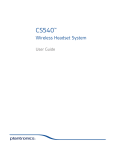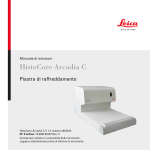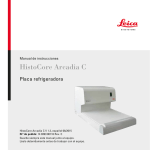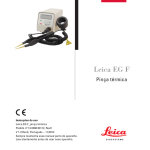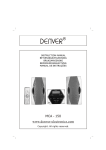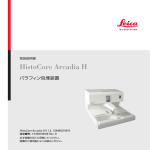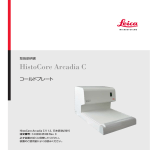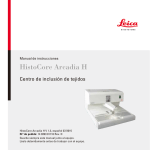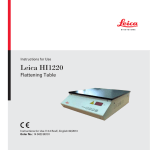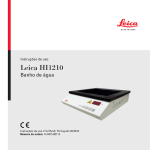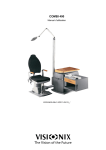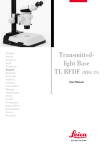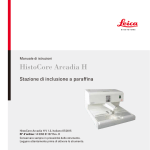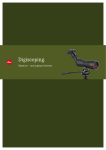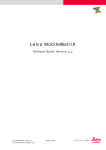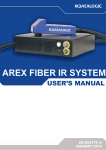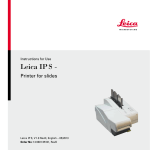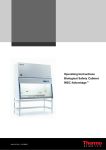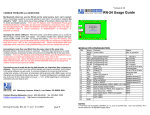Download HistoCore Arcadia C
Transcript
Instructions for Use
HistoCore Arcadia C
Cold Plate
HistoCore Arcadia C V 1.2, English 06/2015
Order No.: 14 0393 80101 Rev. C
Always keep this manual with the instrument.
Read carefully before working with the instrument.
- NOTE
The information, numerical data, notes and v alue
judgments contained in this manual represent
the current state of scientific knowledge and
state-of-the-art technology as we understand it
following thorough investigation in this field.
We are under no obligation to update the p resent
manual periodically and on an ongoing basis
according to the latest technical developments,
nor to provide our customers with additional
copies, updates etc. of this manual.
To the extent permitted in accordance with
the national legal system as applicable in each
individual case, we shall not be held liable for
erroneous statements, drawings, technical
illustrations etc. contained in this manual. In
particular, no liability whatsoever is accepted
for any financial loss or consequential damage
caused by or related to compliance with statements or other information in this manual.
Statements, drawings, illustrations and other
information regarding the contents or technical
details of the present Instructions for Use are
not to be considered warranted characteristics
of our products.
These are determined only by the contract
provisions agreed between ourselves and our
customers.
Leica Biosystems reserves the right to change
technical specifications as well as manufacturing processes without prior notice. Only in this
way is it possible to continuously improve the
technology and manufacturing techniques used
in our products.
This document is protected under copyright
laws. All copyrights to this documentation are
held by Leica Biosystems Nussloch GmbH.
Any reproduction of text and illustrations (or
of any parts thereof) by means of print, photocopy, microfiche, web cam or other methods—
including any electronic systems and media—
requires express prior permission in writing by
Leica Biosystems Nussloch GmbH.
For the instrument serial number and year of
manufacture, please refer to the name plate at
the back of the instrument.
© Leica Biosystems Nussloch GmbH
Leica Biosystems Nussloch GmbH
Heidelberger Str. 17 - 19
D-69226 Nussloch
Germany
Phone: +49 (0)62 24 143-0
Fax:
+49 (0)6224 143-268
Internet:http://www.LeicaBiosystems.com
Assembly contracted to Leica Microsystems Ltd. Shanghai
HistoCore Arcadia C – Cold Plate
1
Table of contents
1. Important Information.................................................................................................................. 3
1.1
1.2
1.3
1.4
1.5
Naming conventions..................................................................................................................... 3
Symbols in the text and their meanings..................................................................................... 3
Instrument type.............................................................................................................................. 6
Intended use of instrument.......................................................................................................... 6
Qualification of personnel............................................................................................................ 6
2. Safety.............................................................................................................................................. 7
2.1 Safety notes.................................................................................................................................... 7
2.2Warnings......................................................................................................................................... 8
3. Instrument Components and Specifications.......................................................................... 10
3.1
3.2
3.3
Overview — instrument components...................................................................................... 10
Main features of the instrument............................................................................................... 10
Technical Data............................................................................................................................. 11
4. Setting up the instrument ......................................................................................................... 13
4.1
4.2
4.3
4.4
4.5
Site requirement.......................................................................................................................... 13
Standard delivery—packing list............................................................................................... 13
Unpacking and installation........................................................................................................ 14
Moving the instrument................................................................................................................ 15
Power supply................................................................................................................................ 16
5. Operation...................................................................................................................................... 17
5.1
5.2
Switching the instrument on...................................................................................................... 17
Replacing the secondary fuse................................................................................................... 17
6. Maintenance and Cleaning....................................................................................................... 18
6.1
6.2
Cleaning the instrument............................................................................................................. 18
Maintenance instructions.......................................................................................................... 18
7. Troubleshooting.......................................................................................................................... 19
8. Warranty and Service................................................................................................................. 20
9. Decontamination Certificate (Master).................................................................................... 21
2
Instructions for Use V 1.2 Rev. C – 06/2015
1. Important Information
1.1
Naming conventions
The full name of the device is HistoCore Arcadia C Cold Plate. The device is called
HistoCore Arcadia C to ensure that the Instructions for Use are well legible.
1.2
Symbols in the text and their meanings
Warnings
appear in a gray box and are marked by a warning triangle
.
Notes,
i.e. important user information appear in a gray box and are marked by an
information symbol
.
(5)
(Figure 5)
Numbers in parentheses refer to item numbers in illustrations or to the illustrations
themselves.
Caution, consult the instructions for use for cautionary information.
Power on.
Power off.
Observe the Instructions for Use
Manufacturer
Date of manufacture
Symbol for alternating current
PE terminal
Order No.
HistoCore Arcadia C – Cold Plate
3
1. Important Information
1.2
Symbols in the text and their meanings
Serial number
Environmental protection symbol of the China RoHS directive. The number in
the symbol indicates the "Environment-friendly Use Period" of the product. The
symbol is used if a substance restricted in China is used in excess of the maximum permitted limit.
Symbol for labeling electrical and electronic equipment in accordance with Section 7 of the German Electrical and Electronic Equipment Act (ElektroG). ElektroG is
the law regarding the sale, return and environmentally sound disposal of electrical
and electronic equipment.
This product fulfills the requirements of the EU directives.
This product fulfills the requirements of the CAN/CSA-C22.2 No. 61010.
The package contents are fragile and must be handled with care.
The package must be kept in a dry environment.
Indicates the correct upright position of the package.
It allows maximum 2 stacks layers.
4
Instructions for Use V 1.2 Rev. C – 06/2015
1. Important Information
1.2
Symbols in the text and their meanings (Continued)
Indicates the temperature range permitted for storing and transporting the
package.
Minimum -29 °C
Maximum +50 °C
Indicates the temperature range permitted for storing the package.
Minimum +5 °C
Maximum +50 °C
Indicates the humidity range permitted for storing and transporting the
package.
Minimum 10 % r.H.
Maximum 85 % r.H
Tip-n-Tell indicator to monitor whether the shipment has been transported and
stored in upright position according to your requirements. With a pitch of 60° or
more, the blue quartz sand flows into the arrow-shaped indicator window and
sticks there permanently. Improper handling of the shipment is immediately
detectable and can be proven definitively.
In the Shockwatch system, a precision glass tube shows shocks or impacts that
are above a specified intensity through red coloration. E xceeding a defined acceleration (g value) destroys the surface tension of the liquid in the interior of the
tube. This causes the indicator tube to change color.
Indicates the item can be recycled where correct facilities exist.
HistoCore Arcadia C – Cold Plate
5
1. Important Information
1.3
Instrument type
All information provided in these Instructions for Use applies only to the instrument
type indicated on the cover page.
A nameplate is attached to the back of the
instrument and a serial number label is on
the side of the instrument.
Fig. 1 is provided as an example only
and shows a valid nameplate for this
instrument with the necessary information about instrument type and power
requirement. The precise data for the
various versions is specified in Chapter 3.3, "Technical data".
Fig.1
1.4
Intended use of instrument
The HistoCore Arcadia C is a cold plate for chilling and blocking out histological tissue samples
in paraffin blocks.
Any other use of the instrument will be considered as improper use!
1.5
Qualification of personnel
• The HistoCore Arcadia C may be operated by trained laboratory personnel only.
• All laboratory personnel designated to operate this instrument must read these Instructions
for Use carefully and must be familiar with all technical features of the instrument before
attempting to operate it.
6
Instructions for Use V 1.2 Rev. C – 06/2015
2. Safety
2.1
Safety notes
The safety and caution notes in this chapter must be observed at all times.
Be sure to read these notes even if you are already familiar with the operation and use
of other Leica Biosystems products.
These Instructions for Use include important instructions and information related to the operating safety and maintenance of the instrument.
These Instructions for Use are an important part of the product, and must be read carefully
prior to startup and use and must always be kept near the instrument.
This instrument has been built and tested in accordance with the safety requirements for electrical equipment for measurement, control, and laboratory use.
To maintain this condition and ensure safe operation, the user must observe all notes and
warnings contained in these Instructions for Use.
These Instructions for Use must be appropriately supplemented as required by the existing regulations on accident prevention and environmental safety in the operator's country.
The protective devices on the instrument and its accessories must not be removed or
modified. Only service personnel qualified by Leica Biosystems may repair the instrument and access the instrument's internal components.
Use only the provided power cable - this must not be replaced with a different power
cable. If the power plug does not fit in your socket, contact our service.
Residual risks
The instrument has been designed and constructed with the latest state-of-the-art technology and according to recognized standards and regulations with regard to safety
technology. Operating or handling the instrument incorrectly can place the user or other
personnel at risk of injury or can cause damage to the instrument or other property. The
instrument may be used only as intended and only if all of its safety features are in proper working condition. Malfunctions that impede safety must be remedied immediately.
For current information about applicable guidelines, please refer to the CE declaration
of conformity and on our Internet site at:
http://www.LeicaBiosystems.com
HistoCore Arcadia C – Cold Plate
7
2. Safety
To prevent damage to the instrument or the specimen, only accessories authorized by
Leica Biosystems may be used.
2.2Warnings
The safety devices installed in this instrument by the manufacturer only constitute the basis
for accident prevention. Operating the instrument safely is, above all, the responsibility of the
owner, as well as the designated personnel who operate, service or repair the instrument.
To ensure trouble-free operation of the instrument, make sure to comply with the following
instructions and warnings.
Warnings – Safety notes on the instrument itself
• This device may only be used by trained laboratory technicians. It must only be
operated for the purpose of its designated use and according to the instructions
contained in these Instructions for Use.
• Safety notes on the instrument itself, which are marked with a warning triangle, indicate that the correct operating instructions (as defined in these
Instructions for Use) must be followed when operating or replacing the item
marked. Nonobservance can cause accidents, injuries and/or damage to the
instrument/accessories.
Safety instructions - Transport and installation
• After unpacking the instrument it may only be transported in an upright position.
• Before connecting the device to a power source, ensure that the voltage indicated on the type plate matches the voltage available at the place of installation.
• The unit must be connected only with the supplied power cable and only to a
grounded power receptacle. Do not use an extension cord.
• The power socket to which the instrument is connected has to be near the
instrument and easily accessible.
8
Instructions for Use V 1.2 Rev. C – 06/2015
2. Safety
• The minimum voltage (see Technical data) must be maintained while starting
the refrigeration unit.
The compressor needs a start-up current of approx. 25 A. A stable power supply
in accordance with the instrument's specifications is essential to its proper functioning. Please ensure that your electrical installation fulfills these preconditions prior to
installing the unit. Nonobservance causes damage to the instrument.
• Switch off the instrument each time before servicing, repairing or cleaning,
and pull out the power plug.
• Failure to observe the instructions specified by the manufacturer may result in
damage to the protection provided by the instrument.
HistoCore Arcadia C – Cold Plate
9
3. Instrument Components and Specifications
3.1
Overview — instrument components
Instrument front view
1
2
4
3
5
6
3.2
1. Power switch
4. Heat sink
2. Refrigeration system (inside)
5. Port for power inlet
3.Cooling surface
6. AC fuses
Fig.2
Main features of the instrument
• The instrument is distinguished by a simple, modular design and a powerful refrigeration unit
with precisely controlled cooling performance.
• The environment adaptive control module ensures the working temperature always stabilized
at -6 °C.
• High cooling performance ensures that the instrument's working temperature is reached
quickly.
• Optimized temperature distribution in the cold plate prevents dripping condensation.
• The generously-dimensioned cooling surface has room for around 60 blocks.
• Designed to be used with the HistoCore Arcadia H Paraffin Embedding Station.
10
Instructions for Use V 1.2 Rev. C – 06/2015
3. Instrument Components and Specifications
3.3
Technical Data
General data
Voltage of power supply
Instrument type
HistoCore Arcadia C
Power supply voltage
Order Number
220-240 VAC 50/60Hz
14 0393 53599
110-120 VAC 50/60Hz
14 0393 54092
100 VAC 50/60Hz
14 0393 54091
Fuse
Time-lag fuses 5 x 20 mm, 2xT5A, 250V
Nominal current
5 A max.
Maximum start-up current (5 s)
25 A
Environmental operating temperature range
+20 °C to +30 °C
Operating temperatures
-6 °C
Environmental relative humidity
20 to 80 % - non-condensing
Environmental operating altitude
Up to 2000 m
Permissible temperature range
during storage
+5 °C to +50 °C
Permissible temperature range
during transport
-29 °C to +50 °C
Permissible humidity range
during storage and transport
10 to 85 % - non-condensing
Electromagnetic environment
Basic electromagnetic environment
IEC 61010 classification
Protection class 1
Pollution degree
2
IP protection class (IEC 60529)
IP20
Refrigeration unit
Refrigeration capacity*
158 W( at 50Hz) ;185 W( at 60Hz)
Safety factor
3
Refrigerant
R 134a
HistoCore Arcadia C – Cold Plate
11
3. Instrument Components and Specifications
3.3
Technical Data (Continued)
Compressor oil
150 +10/-5 ml Ester RL7H, ISO 7
* according to ASHRAE, condensing temperature: 54.4 °C, evaporating temperature: -23.3 °C
Coolant
115 g ± 2 g
Dimensions and weights
Width:
400 mm
Depth:
605 mm
Height:
385 mm
Weight:
30 kg
12
Instructions for Use V 1.2 Rev. C – 06/2015
4. Setting up the instrument
4.1
Site requirement
• Stable, vibration-free laboratory table with horizontal, flat table top, as far as possible vibration-free ground.
• No direct sunlight or strong temperature fluctuations. Room temperature consistently between +20 °C and +30 °C.
• Relative air humidity maximum 80 %, non-condensing.
• The instrument should be set up in such a way that the air circulation is not impaired.
• The instrument must be installed in a place that ensures an easy disconnection from the
power supply. The power cable must be in a place that can be easily reached.
At a room temperature of > +30 °C, the working temperature of the cold plate of -6°C
may not be reached at all points.
To ensure proper function and an easy disconnection of the power cable from the instrument, there must be gap of at least 15 cm b ehind the instrument. Failure to observe
this distance may result in serious damage to the refrigeration unit of the device. The
instrument should not be operated in hazardous locations.
4.2
Standard delivery—packing list
Qty
Designation
1
Basic unit HistoCore Arcadia C,
Order No.
220-240 VAC
14 0393 53599
220-240 VAC, China
14 0393 54102
110-120 VAC
14 0393 54092
100 VAC
14 0393 54091
1
Power cord
See page 16
4
Sets of spare fuses, 250 V 5A
14 6000 05015
1
Instructions for Use (printed German/English with language CD 14 0393 80200) 14 0393 80001
Please compare the delivered components against the packing list and your order. Should
there be any discrepancy, please contact the Leica Biosystems distributor handling your
order.
HistoCore Arcadia C – Cold Plate
13
4. Setting up the instrument
4.3
Unpacking and installation
When the instrument is delivered, check the tilt indicators on the packaging.
If the arrowhead is blue, the shipment was transported laying flat, was tilted at
too great an angle or fell over during transport.
Note this on the shipping documents and check the shipment for possible damage.
These unpacking instructions only
apply if the box is placed with the
symbols
facing upwards.
1
2
3
1. Remove the packing strap (1) and the adhesive
tape (2).
2. Open the package. Lift up and remove the
carton wall (3).
3. Remove the foam pads (4) one by one.
Fig.3
4
4
The HistoCore Arcadia C always has
to be transported upright and horizontally. It must not be inverted under any
circumstances, even for short periods,
or stored on one of its sides.
Fig.4
14
It is mandatory to observe a waiting time of 4
hours between the
last
transport and the first time the
instrument is switched on. The oil
present in the compressor needs
this time to flow back to its original
location.
Instructions for Use V 1.2 Rev. C – 06/2015
4. Setting up the instrument
4.3
Unpacking and installation (Continued)
4. Ensure that when removing the instrument (5)
from the pallet this is carried out by two people
lifting four lower corners of the housing base
(Fig. 5).
5. Place the instrument on a stable laboratory
table.
6. Remove the accessories from the accessory
box (6) on the base of the pallet.
5
Fig.5
The packaging must be retained for
the duration of the warranty period.
To return the instrument, follow the
instructions above in reverse order.
6
Fig.6
4.4
Moving the instrument
Do not move the instrument during operation.
Before moving the instrument, make sure that there is no specimen blocks on the cold
plate, the instrument is at an ambient temperature, and the power cord is disconnected
from the power supply.
Do not touch the metal parts of the compressor air outlet (1) on the rear panel.
It is mandatory to observe a waiting time of 4 hours before the instrument is switched
on.
Hold the instrument at the front and rear part of
the lower housing base and move.
1
Fig.7
HistoCore Arcadia C – Cold Plate
15
4. Setting up the instrument
4.5
Power supply
The HistoCore Arcadia C refrigeration unit requires a specific voltage and frequency (refer to
"Technical data" chapter), and is therefore always delivered with a power cord that fits the
instrument.
Please observe the following notes to prevent damage to the instrument.
Before connecting the instrument to the power supply, it is mandatory to check whether
the voltage specified on the identification label (rear side) matches the actual voltage
values at the installation location.
If this is not the case, the connection must not be made!
The unit must be connected only with the supplied power cord and only to a grounded
power receptacle.
Do not use an extension cord!
Depending on the application area, one of the
following cables is delivered along with the instrument:
6
7
Fig.8
• Connect the power cord plug (7) to the
connecting port (6).
• Plug the power cord into the wall outlet.
16
Designation
Order No.
USA
14 6000 05024
Japan
14 6000 05025
Brazil
14 6000 05026
Europe
14 6000 05027
China
14 6000 05028
Australia
14 6000 05029
United Kingdom
14 6000 05030
Switzerland
14 6000 05066
Italy
14 6000 05067
Denmark
14 6000 05068
Argentina
14 6000 05070
Instructions for Use V 1.2 Rev. C – 06/2015
5. Operation
5.1
Switching the instrument on
After installation as described in Chapter 4, the HistoCore Arcadia C is ready for
operation. Switch on the device with the Power switch at the front left of the
instrument ("I" = ON). A lamp lights up in the switch to indicate that the unit is operational and the refrigeration unit will start working.
Depending on the room temperature, the time to reach the target temperature of
the cooling surface (-6 °C) will be around 25 minutes.
Fig.9
The cooling surface may not be loaded with molds until the cooling time
has elapsed. Otherwise, the working temperature of -6 °C may not be
reached.
The compressor will start to work in five minutes after the power is on.
5.2
Replacing the secondary fuse
A miniature fuse to protect the electronic components is
located on the rear of the instrument.
Fuse rating: 5A, 250 V
Before replacing the fuse, always switch the
instrument off and pull the power plug from the
wall socket.
Only miniature fuses of the type specified in the
chapter "Technical data" can be used.
9
10
Fig.10
HistoCore Arcadia C – Cold Plate
To replace the fuse, please proceed as follows:
1. Use a screwdriver to open the fuse holder (9) and
remove the fuses (10).
2. Replace them with two new fuses of the same type.
3. Use the screwdriver to press the fuse holder back to
its original location.
4. Reconnect the instrument to an AC power outlet and
switch it on.
17
6. Maintenance and Cleaning
6.1
Cleaning the instrument
Switch off the instrument and pull out the power plug each time before cleaning.
While handling cleaning materials, observe the safety regulations of the manufacturer
and the lab regulations valid in the country of use.
During cleaning, do not allow any liquid to penetrate inside the instrument!
To prevent scratching the surface of the instrument, do not use metallic tools with sharp
edges under any circumstances.
Work surfaces
• All common laboratory cleaning products suitable for the removal of paraffin (e.g. Polyguard
or xylene substitutes) can be used to clean the work area.
• Use a dry, lint-free tissue paper to clean the condensed water on the cold plate.
Instrument and exterior surfaces
• If necessary, clean the painted exterior surfaces with a mild household cleaner or soapy
water and wipe with a damp cloth.
• Avoid prolonged contact of organic solvents on the surface of the instrument. Do not use
xylol, acetone or alcohol on the painted surfaces!
6.2
Maintenance instructions
Only Leica Biosystems service technicians are authorized to open the instrument for maintenance and repair work.
Please observe the following points to ensure the instrument's reliable function over extended
periods:
• Clean the instrument with care after each use.
• Regularly remove dust from the ventilation slots on the back of the instrument with a brush
or vacuum cleaner.
• Enter into a service contract at the end of the warranty period. For more information, contact
the relevant Leica Biosystems customer service organization.
18
Instructions for Use V 1.2 Rev. C – 06/2015
7. Troubleshooting
If you cannot solve your problem using the help in the following table, please contact your L eica
Biosystems customer service organization or the Leica Bosystems dealer from whom you purchased the instrument.
Error condition
Possible causes
The cold plate cannot cool
Inadequate air supply to ventidown to the target temperature lation unit.
and the alarm beeps twice.
Or
The cold plate is malfunctioned.
Corrective action
1. Make sure that enough
space is reserved between the
wall and the instrument. It must
be at least 15 cm.
2. Wait about 5 minutes and
restart the instrument.
3. If the problem persists,
contact customer service.
The cold plate cannot cool
Ambient temperature is too
down to the target temperature high.
but no alarm.
Or
Too much condensated
water/ice/frost on the cold
plate surface.
1. Make sure that the room
temperature is 20~30 °C.
2. Make sure that enough
space is reserved between the
wall and the instrument. It must
be at least 15 cm.
3. Clean the cold plate and
restart the instrument.
4. If the problem persists,
contact customer service.
The temperature of the cold
plate is too low and the alarm
beeps steady (may cause
cracks on the paraffin blocks).
HistoCore Arcadia C – Cold Plate
The cold plate is
malfunctioned.
1. Restart the instrument.
2. If the problem persists,
contact customer service.
19
8. Warranty and Service
Warranty
Leica Biosystems Nussloch GmbH guarantees that the contractual product
delivered has been subjected to a comprehensive quality control procedure
based on the Leica Biosystems in-house testing standards, and that the
product is faultless and complies with all technical specifications and/or
characteristics warranted.
The scope of the warranty is based on the content of the concluded agreement. The warranty terms of your Leica Biosystems sales organization or
the organization from which you have purchased the contractual product
shall apply exclusively.
Service information
If you require technical service or replacement parts, please contact your
Leica Biosystems sales representative or dealer who sold the product.
Please provide the following information:
•
•
•
•
Model name and serial number of the instrument.
Location of the instrument and name of the person to contact.
Reason for the service call.
Date of delivery.
Decommissioning and disposal
The instrument or parts of the instrument must be disposed of in compliance
with the local laws.
20
Instructions for Use V 1.2 Rev. C – 06/2015
9. Decontamination Certificate (Master)
Decontamination Certificate
Dear Customer,
Any product that is to be returned to Leica Biosystems or serviced on site, must be cleaned and decontaminated in the appropriate manner. Since it is not possible to
decontaminate for prion diseases, such as CJD, BSE, CWD etc., equipment exposed to specimens containing prion diseases cannot be returned to Leica Biosystems
for repair. On-site repair of prion contaminated equipment will only be conducted after the Field Service Engineer has been educated in the risks, instructed in the
policies and procedures of the institution, and provided with personal protective equipment. Please fill out this confirmation carefully and enclose a copy with the
instrument. Attach the confirmation to the outside of the flight case or hand it directly to the service technician.
Packages will not be opened, nor servicing commenced until the Company or service engineer have received a satisfactory certificate. Should returned
goods be considered a hazard by the Company, they will be returned immediately to the customer at his/her expense. Note: Microtome knives must be in boxes.
Mandatory information: Fields marked with * are mandatory. Depending on whether the instrument is contaminated, please also complete either section A
or section B.
SN (see nameplate)*
Nameplate information
Model (see nameplate)*
REF (see nameplate)*
Tick Box A if applicable. Otherwise please complete all parts of B, providing further
information as requested or appropriate.
A
B
Yes
Yes
No
This equipment has not been in contact with unfixed biological samples.
1
This equipment has been exposed internally or externally to hazardous materials as indicated
below:
Please provide further detail here:
Blood, body fluids, pathological samples
Other biohazards
Chemicals/substances hazardous to health
Other hazards
Radioactivity
Yes
No
2 This equipment has been cleaned and decontaminated:
Please provide further detail here:
If yes, give details of the method:
If no**, please indicate why not:
** Such equipment must not be returned without the written agreement of Leica Biosystems.
Yes
No
equipment has been prepared to ensure safe handling/transportation.
3 The
Whenever possible, please use the original transportation case/box.
Important - to avoid refusal of shipment:
Place one copy in the unit prior to packaging, or hand it over to the service engineer. Customer assumes all responsibility for the
immediate return shipment of articles sent to Leica without proper decontamination documentation.
If you have any further questions, please call your local Leica organization.
Leica Internal Use: If applicable, note corresponding Job and RAN-/RGA-Number:
BU Return Authorization Number: ______________
HistoCore Arcadia C – Cold Plate
Name*
Institute*
Department*
SU Return Goods Authorization: ______________
21
er-No. 14 0700 83101
Job Sheet No.: _______________
Signature/Date*
** Such equipment must not be returned without the written agreement of Leica Biosystems.
9. Decontamination
Certificate
(Master)
Yes
No
The equipment has
been prepared to ensure safe handling/transportation.
3 Whenever possible, please use the original transportation case/box.
Important - to avoid refusal of shipment:
Place one copy in the unit prior to packaging, or hand it over to the service engineer. Customer assumes all responsibility for the
immediate return shipment of articles sent to Leica without proper decontamination documentation.
If you have any further questions, please call your local Leica organization.
Leica Internal Use: If applicable, note corresponding Job and RAN-/RGA-Number:
BU Return Authorization Number: ______________
Institute*
Department*
Name*
Address*
Position*
eMail
Leica Biosystems Nussloch GmbH
Heidelberger Str. 17-19
69226 Nussloch, Germany
22
SU Return Goods Authorization: ______________
Phone*
Fax
Phone: ++49 (0) 6224 143 0
Fax: ++49 (0) 6224 143 268
www.LeicaBiosystems.com
Instructions for Use V 1.2 Rev. C – 06/2015
Version 3.5 - 01/2013, Order-No. 14 0700 83101
Job Sheet No.: _______________
Signature/Date*
www.LeicaBiosystems.com
Leica Biosystems Nussloch GmbH
Heidelberger Strasse 17-19
D- 69226 Nussloch
Tel.: +49 - (0) 62 24 - 143 0
Fax: +49 - (0) 62 24 - 143 268
Web: www.LeicaBiosystems.com


























